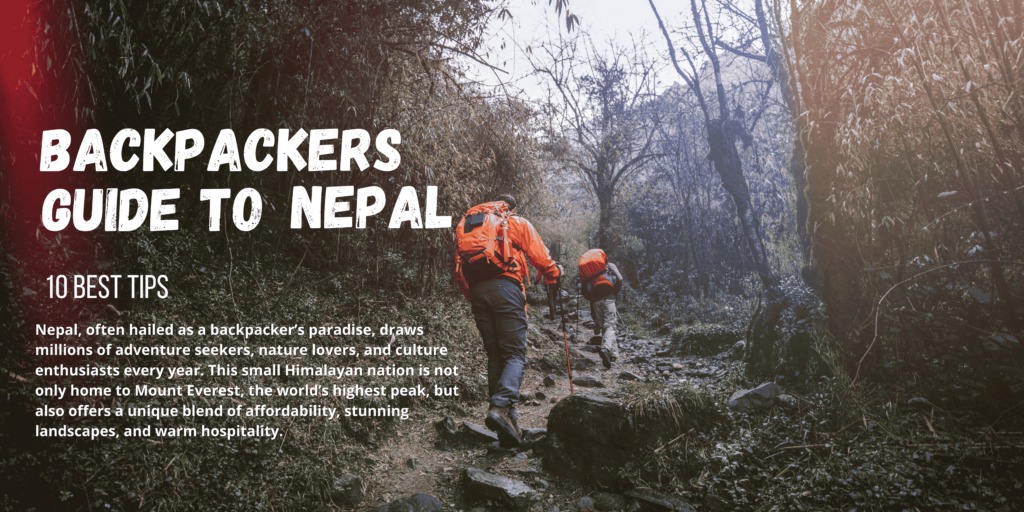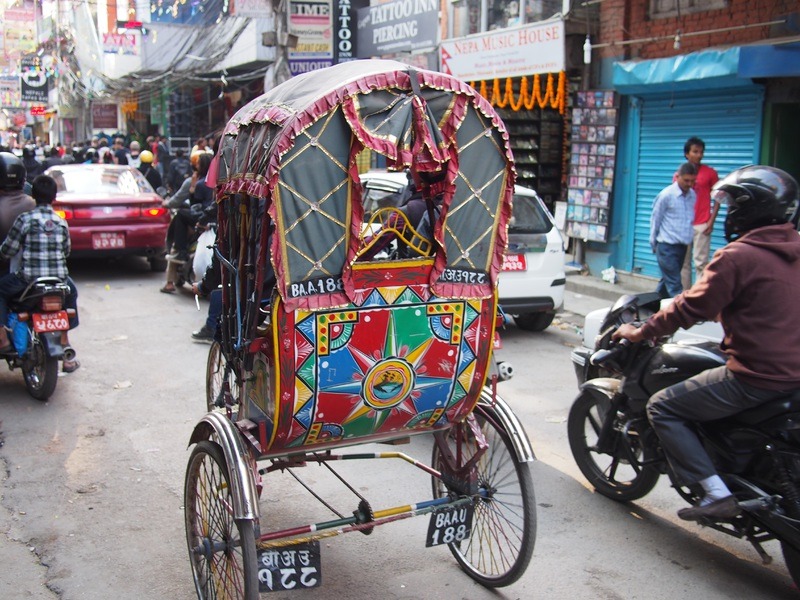Nepal, often hailed as a backpacker’s paradise, draws millions of adventure seekers, nature lovers, and culture enthusiasts every year. This small Himalayan nation is not only home to Mount Everest, the world’s highest peak, but also offers a unique blend of affordability, stunning landscapes, and warm hospitality.

With majestic mountains, rich cultural heritage, and wallet-friendly options for accommodation and food, Nepal has become an ideal destination for budget-conscious travelers. But before embarking on this exciting backpacker’s guide to Nepal, there are a few things every backpacker should know.
10 best tips for backpackers during Visit to Nepal
Nepal Backpacking: Easy Visa Access and Costs
One of the first questions that arise for any traveler is the visa process. Fortunately, Nepal makes it quite easy for visitors by offering visas on arrival to citizens of most countries. Upon arrival at one of Nepal’s airports or border crossings, you can expect to pay a visa fee based on the length of your stay.
Currently, the visa fees are quite reasonable, with options of $100 for a 90-day visa, $40 for a 30-day stay, or $25 for a shorter 15-day visit.

A notable point is that you cannot pay for your visa in local currencies like the Nepalese Rupee or Indian Rupee. It’s a good idea to carry foreign currencies such as USD, GBP, or EUR, or you can take advantage of currency exchange services available at the airport. For those who prefer using credit cards, that’s also an option, although an extra fee may apply.
Once in the country, travelers who decide to extend their stay can do so by applying online before visiting the immigration office. Visa extensions cost around $2 per day, making it easy to lengthen your adventure in this scenic country.
Nepal Backpacking Costs: Exploring on a Budget
Nepal’s reputation as an affordable destination holds strong for budget travelers. Costs tend to decrease as you move away from major cities like Kathmandu and Pokhara toward more rural areas, where the pace of life is slower and prices reflect the simplicity of the surroundings.
If you’re strategic, $30 per day can comfortably cover your basic expenses. Opting for local homestays over hotels, indulging in street food rather than dining in upscale restaurants, and using local transportation (like the ever-charming rickshaws) instead of tourist buses are just a few ways to keep your budget in check.
While a guide can enhance your trekking experience or city exploration, it’s not always necessary if you’re equipped with a map or a GPS app. Many travelers have found joy in hitchhiking across Nepal, which is both adventurous and budget-friendly.
Tips for Reducing Travel Costs in Nepal
Backpacking in Nepal on a budget doesn’t mean sacrificing comfort or adventure. In fact, by embracing the local culture, you can find unique opportunities that are often missed by tourists who stick to the beaten path.
-
Accommodation: Choose guesthouses, hostels, or homestays. Nepal’s tourism industry thrives on small family-run businesses that offer cozy stays for a fraction of the cost of hotels. Hostels in popular areas like Thamel in Kathmandu provide dormitory-style lodging that’s both clean and affordable.
-
Food: Street food in Nepal is a must-try, offering flavors unique to the region. Dishes like momos (dumplings) or dal bhat (a traditional rice and lentil meal) are both filling and inexpensive. Avoid tourist-oriented restaurants where prices can be inflated.
-
Transportation: Local buses and shared taxis are much cheaper than private cars or tourist buses. In cities like Kathmandu, rickshaws and motorbikes provide cheap and convenient rides, while long-distance travel between cities can be done through local buses for a fraction of the cost of tourist transport.
However, as you move further into rural regions, keep in mind that the prices of basic amenities like food may increase due to the logistical difficulties of transporting goods into more remote areas. Always plan your meals and water supplies carefully when trekking or exploring off the beaten path.
Staying Safe and Healthy While Backpacking in Nepal
Nepal is generally considered a safe destination for travelers, but like any country, it comes with its own set of challenges. Staying mindful of your surroundings and taking the right precautions can ensure that your journey remains stress-free.
-
Tracking Your Expenses: It’s easy to get carried away with spending when traveling, so make sure to track every bill and expenditure. This helps in budgeting better and ensures you don’t run out of cash mid-trip.
-
Safety for Women Travelers: Nepal is welcoming to solo female travelers, but safety measures are essential, especially when traveling alone. Avoid venturing out alone at night and communicate frequently with your accommodation provider or fellow travelers to stay informed.
-
Health Concerns: Nepal’s street food is delicious, but always prioritize hygiene. Opt for foods that are freshly cooked, and stay away from tap water unless it’s been boiled or filtered. It’s a good idea to carry a reusable water bottle with a built-in filter, especially if you’re trekking in remote regions where clean water may be hard to come by.
-
Illegal Activities: While cannabis grows wildly in some regions of Nepal, drug use is strictly illegal and penalties are severe. Always be mindful of local laws to avoid getting into trouble. Engaging in illegal activities like buying or selling drugs can not only ruin your trip but also land you in serious legal trouble.
Things to Avoid While Backpacking in Nepal
When visiting Nepal, it’s important to be aware of local customs and regulations to avoid falling into any trouble. These simple guidelines will help ensure that your trip remains safe, fun, and memorable:
-
Avoid Flashing Valuables: Nepal is a relatively safe country, but theft and pickpocketing can occur in crowded places like markets or bus stations. Keep your belongings secure and avoid drawing unnecessary attention by flashing expensive items.
-
Don’t Offend Local Culture: Nepali culture is deeply rooted in tradition. Always be respectful when visiting temples, stupas, and other sacred sites. Dress modestly, take your shoes off when entering religious buildings, and always ask for permission before taking photographs of people, especially monks or locals in traditional dress.
-
Environmental Awareness: Nepal’s natural beauty is unmatched, but with its growing tourism, environmental issues like littering have become a concern. Always dispose of waste properly, especially in trekking areas, and consider supporting eco-friendly tourism initiatives that focus on sustainable practices.
Backpacker’s Essentials: What to Pack for Nepal
Preparing for your adventure in Nepal requires packing wisely, especially if you plan to trek or visit rural areas. Here’s a quick checklist of essential items:
-
Trekking Gear: If you’re planning to hike, bring sturdy, broken-in hiking boots, moisture-wicking clothing, and a durable backpack. A sleeping bag and trekking poles are also highly recommended for longer trips.
-
Clothing: The climate in Nepal varies widely depending on the region and time of year. Pack layers to adjust to the temperatures, especially if you plan to visit higher altitudes where it can get chilly even during the day.
-
First Aid Kit: Always carry a basic first aid kit, including any prescription medications, painkillers, band-aids, and hand sanitizer.
-
Reusable Water Bottle: A necessity for staying hydrated on the go, particularly with a filter to purify water in rural areas.
Backpacking through Nepal offers the experience of a lifetime for those seeking adventure, culture, and breathtaking landscapes. With its affordability, warm hospitality, and countless trails leading into the heart of the Himalayas, it’s no wonder that Nepal continues to be a top destination for backpackers from all corners of the globe. Whether you’re planning a short visit to the cities or embarking on a trek to Everest Base Camp, Nepal guarantees an unforgettable journey without breaking the bank.
-
Can I get a visa on arrival in Nepal?
Yes, most travelers can obtain a visa on arrival at Kathmandu’s Tribhuvan International Airport or border crossings. The cost depends on your stay length (15, 30, or 90 days).
-
How much money do I need per day as a backpacker in Nepal?
On average, $30 per day will cover basic accommodation, meals, and local transportation for budget-conscious travelers.
-
Is it safe for women to travel alone in Nepal?
Nepal is generally safe for solo female travelers, but it’s important to take precautions, such as avoiding isolated areas at night and staying in contact with fellow travelers or hotel staff.
-
What’s the best way to travel between cities in Nepal?
Local buses and shared taxis are the most affordable ways to travel between cities. They may be slower but offer a chance to experience local life more authentically.
-
Are there any health concerns when traveling in Nepal?
Travelers should be cautious of food and water. Avoid tap water and choose cooked street food from trusted vendors. Carry a reusable water bottle with a filter for trekking.
-
Can I trek in Nepal without a guide?
Yes, many treks in Nepal can be done without a guide, but if you’re unfamiliar with the trails, hiring a guide can enhance the experience and ensure safety in remote areas.